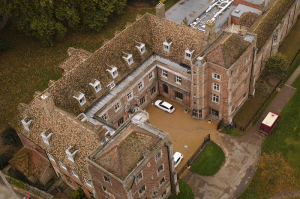Yesterday I had the chance to visit the British Library’s exhibition on the Gothic, entitled ‘Terror and Wonder: The Gothic Imagination’. The exhibition traces the evolution of the ‘Gothic sensibility’, and its cultural transformation, from 1764 to the present day. 1764 was, of course, the date of the publication of Horace Walpole’s The Castle of Otranto, which is generally accepted as the first English Gothic novel and, indeed, the first literary ghost story. The exhibition’s first exhibit was the first and second editions of the book, which was originally passed off as a medieval narrative by a Canon of the Church of St Nicholas, Otranto, ‘discovered in the library of an ancient Catholic family in the north of England’.
It would not be an exaggeration to say that a key component of the Gothic, and certainly the early Gothic, was a delight in the exotic and dark aspects of Catholicism. The Gothic in the late eighteenth and early nineteenth centuries is an inverted form of anti-Catholicism, where the fact that Catholic practices were regarded as an object of horror is turned into entertainment. This aspect of the Gothic certainly endured beyond the novels of Mrs Radcliffe like The Italian: or, the Confessional of the Black Penitents (1797) and Matthew Lewis’s The Monk (1796); the exhibition also contained a poster advertising Mysteries of a London Convent (1866), a book about the abduction of a wealthy heiress to a convent in contemporary London. When she does not yield to the advances of a lecherous priest she is condemned to be immured alive in a sinister nocturnal ceremony, complete with black-hooded figures representing the Inquisition.
Anti-Catholicism (or an inverted, celebratory form of it) may have been intrinsic to the Gothic, but the pioneers of the Gothic also had a deep fascination with Catholic artifacts. On display was a 12th-century Limoges casket reliquary of St Thomas Becket which was given to Horace Walpole by the antiquary William Cole. The exhibition also featured another of Walpole’s prize possessions, John Dee’s ‘shewing stone’ in which Edward Kelley scryed for him. It is a highly polished Aztec obsidian mirror which is usually on display in the British Museum; not usually on display is its case, which contains intriguing scribbled notes by Walpole. The exhibition made me long to go back in time and visit Walpole’s ‘cabinet of curiosities’ at Strawberry Hill.
Perhaps my favourite exhibit in the whole exhibition was the cabinet containing seven ‘horrid novels’, inspired by the horrid novels given to Catherine Morland in Jane Austen’s Northanger Abbey. These were all published by the Minerva Press before 1798, when Austen wrote Northanger Abbey, and included such gems as The Necromancer (translated from the German of Karl Friedrich Kahlert in 1794) and the best title of all, Horrid Mysteries (1796). I was also intrigued to read about a ‘Gothic pageant’ staged by a Derbyshire landowner, Sir Brooke Boothby, as early as 1783, which included knights, damsels in distress and wizards. I was left wondering what Sir Brooke’s recusant neighbours would have thought of all this. Also exhibited was a copy of Ebenezer Sibly’s Astrology, A New and Complete Illustration of the Occult Sciences (1806), one of the first printed books in England devoted to practical occultism since Robert Turner’s publications in the 1650s. The exhibition’s only major omission was Francis Barrett’s notorious book The Magus (1801).
However, the exhibition also contained evidence of Catholics who experimented with the Gothic themselves, such as John Polidori, the author of The Vampyre (Catholics writing the Gothic is something I wrote about in English Catholics and the Supernatural; another example is Elizabeth Inchbald who, like Austen, essentially parodies the style). As the exhibition moved into the nineteenth century I was delighted to see a first edition of Joseph Sheridan LeFanu’s ‘Carmilla’ (the first story to feature a lesbian vampire). I was still more delighted that the exhibition had a section concentrating on the nineteenth-century decadents, featuring a copy of The Yellow Book.
The great writers of ghost stories were not left out – here was a first edition of M. R. James’s Ghost Stories of an Antiquary and the original manuscript of ‘Casting the Runes’. Arthur Machen and Algernon Blackwood shared a cabinet, which featured a first edition of Machen’s collection The House of Souls (1906), whose cover is still truly disturbing. Machen is, in my view, the greatest writer of macabre literature who ever lived.
All in all, I was extremely impressed by an exhibition that paid homage to authors that, whilst very important to me, are generally not widely recognised for their achievements. The exhibition runs until 20th January – pay a visit if you dare!




